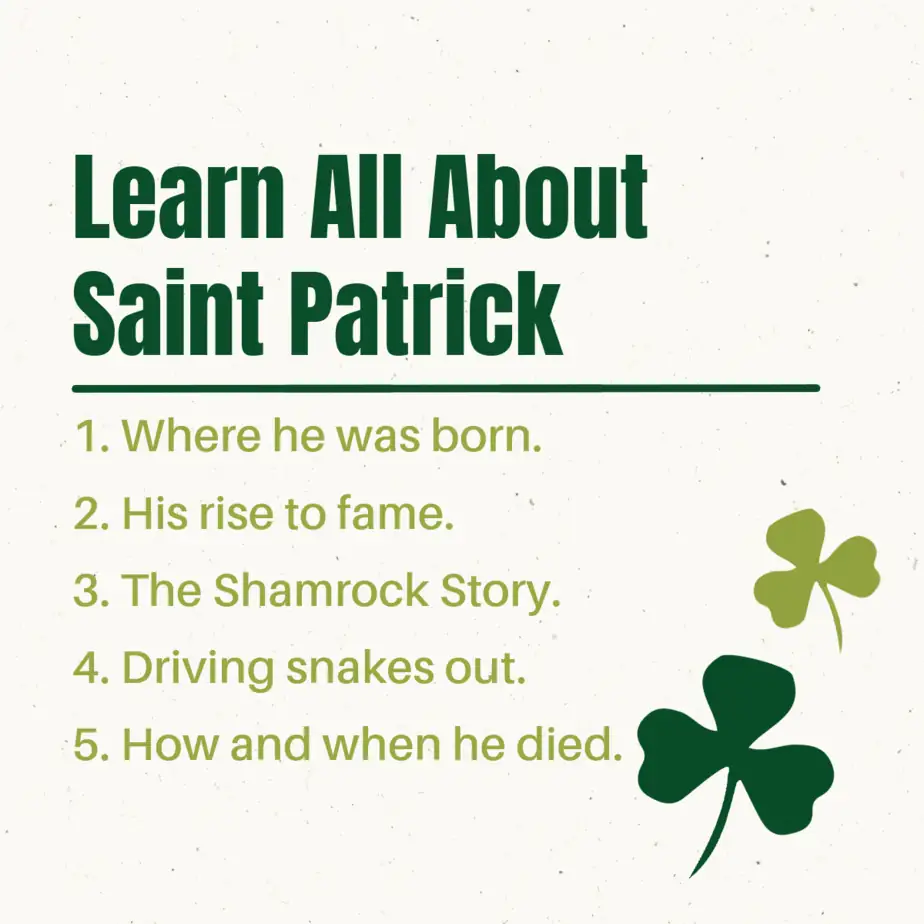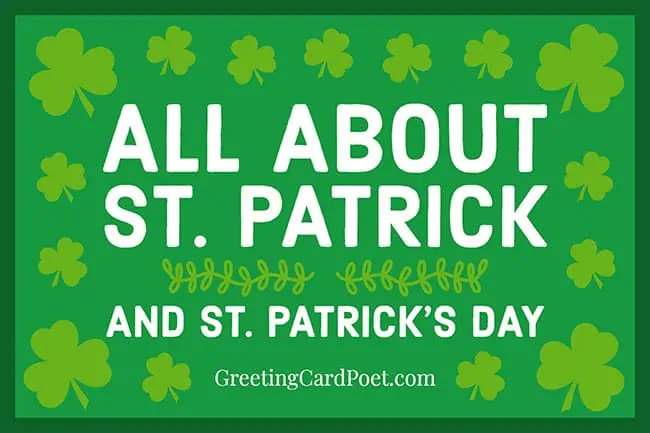Saint Patrick FAQ
Many of us celebrate St. Patrick’s Day, but not many folks know about St. Patrick and the origin of the holiday.
Originating in Ireland, Saint Patrick’s Day is celebrated annually in the country and throughout the world. Irish Americans have elevated the holiday to a different level with parades, parties, and the dyeing of rivers and bodies of water green in celebration.
To know more about St. Patrick and his day, we must learn about his background. And, to think, the patron saint of Ireland is a Roman Brit. Read on to find out more.

St. Patrick’s Day Origin
Learn all about Ireland’s saint.
Who was St. Patrick?
He was a Romano-British Christian missionary and bishop from the fifth century in Ireland. An active missionary in Ireland then, he became known as the “Apostle of Ireland” and the “Enlightener of Ireland.”
Patrick is regarded with great respect in the Catholic Church, Eastern Orthodox Church, Anglican communion, and Lutheranism.
What was St. Patrick’s birth name or real name?
The name St Patrick was given when he was born Maewyn Succat. He then changed his name to Patrick or Patricius after he became a priest. Patrick or Patricius means “father figure.”

When was St. Patrick born?
Historians believe that he was born in AD 390.
Where was St. Patrick born?
Saint Patrick was born in Roman Britain. While the exact location cannot be accurately said, some say it was England, while others also say Glannoventa, Scotland, and Wales.
Was St. Patrick Italian?
His father’s name was Calphurnius, and his mother was Conchessa. They were both Romans residing in England. Based on this, it can be said that Saint Patrick’s lineage was Italian.
Check out our Happy St. Patrick’s Day Captions
What nationality was St. Patrick?
Based on his birthplace, St. Patrick was British. It may come as a surprise as most people assume that he was Irish, which he wasn’t. An understanding of that fact can be achieved upon learning more about his background.
What is St. Patrick, the patron saint of?
He is the patron saint of Ireland. He is also a patron of Nigeria, Montserrat, Archdiocese of New York, Roman Catholic Archdiocese of Newark, Boston, Rolla, Missouri, Loíza, Puerto Rico, Murcia, Clan Giolla Phádraig, engineers, paralegals, and Archdiocese of Melbourne.
What did St. Patrick do?
He converted Ireland to Christianity in the fifth century.
What is St. Patrick known for?
Although St. Patrick’s father was a deacon, Patrick was not a firm believer. When he was around 16, he was kidnapped by Irish pirates and taken away from his home in Britain to Ireland. There Patrick looked after sheep and other animals for six years before escaping.
During his time in captivity, he claimed to have come closer to God. Patrick explained that the Lord had mercy on his ignorance and youth and allowed him to have his sins forgiven and convert to Christianity.
There, he worked, prayed, and built his relationship with God, developing his spirituality. He then switched to Christianity eventually.
After six years in captivity, he heard a voice telling him that he would go home soon. He was also said that he would go back more quickly and that the ship he would be needed was ready.
So he fleed his master and went to the port to find a boat which he boarded to return home. He then continued to study Christianity.
A few years after returning home, he had a vision. In the vision, he had seen a man who he perceived to be Irish.
The man’s name was Victorious, and he had many letters in his hand, one of which he gave to Patrick. The message had the heading “The Voice of the Irish.”
He said that as he read the letter, he could hear the voice of the people calling out to him and saying, “We appeal to you, holy servant boy, to come and walk among us.”
Christian Missionary
Responding to this call, Patrick returned to Ireland as a Christian missionary. After that, he baptized thousands of people and ordained priests to lead the newly baptized Christians. Some of the people he had converted were wealthy women and sons of kings.
However, Patrick’s preaching of Christianity in Ireland did not come without obstacles. He refused to accept gifts and presents from kings and other wealthy people. These actions put him at odds with them as they saw it as an act of rudeness.
What did he drive out of Ireland?
Legends say that he drove away snakes from Ireland. It credits the banishment of reptiles from the country to Patrick. However, many view this fact with skepticism, although perhaps the statement is used in more of a figurative sense.
What is the Saint Patrick Shamrock Story?
Legend has it that St. Patrick used the shamrock – a three-leaf young clover – to explain the Holy Trinity concept to Irish people. Shamrock plants grow wild throughout much of the Emerald Isle.
The three leaves of the shamrock represent the Father, Son, and Holy Spirit. The tradition of wearing shamrocks on St. Patrick’s Day dates back to the early 1700s.
St. Patrick’s Cathedral
St. Patrick’s Cathedral in Dublin, Ireland, was founded in 1191. It is the National Cathedral of the Church of Ireland.
It is the tallest church in Ireland and the largest. The cathedral receives no state funding but still welcomes all into it. It hosts many public ceremonies of the nation.
Manhattan, New York, is a Neo-Gothic decorated Roman Catholic cathedral considered a prominent landmark of the city. It is the largest decorated Gothic-style cathedral in the United States. It was built in 1878.
St. Patrick’s Breastplate
St. Patrick’s Breastplate is a prayer of protection. It is also known as the Deer’s Cry, The Lorica of Saint Patrick. It was traditionally attributed to Saint Patrick in the 5th century.
Musical adaptations of it are:
St. Patrick’s Breastplate in the Irish Church Hymnal (1890) by Irish composer Thomas Richard Gonsalvez Jozé (1853–1924).
St. Patrick’s Breastplate (1902) was by the Irish composer Charles Villiers Stanford (1852–1924). This is the best-known arrangement of this hymn.
St. Patrick’s Breastplate (1912), an arrangement by Charles Villiers Stanford (1852–1924).
St. Patrick’s Breastplate (1924), a work for mixed choir and piano by the English composer Arnold Bax (1883–1953).
The Hymn of St. Patrick at Tara (1930) mixed choir and organ by Irish composer Dermot Macmurrough – a.k.a. Harold R. White, 1872–1943 – to a poetic interpretation by Olive Meyler.
St. Patrick’s Hymn (1965) by US folk-guitarist John Fahey (1939–2001) on the album “The Transfiguration of Blind Joe Death.”
Christ Be Beside Me (also Christ Beside Me), and This Day God Gives Me, adaptations by James J. Quinn to the tune of Bunessan, published in his 1969 book New Hymns for All Seasons
The Deer’s Cry (1983) by Irish composer Shaun Davey (born 1948), based on a translation by Kuno Meyer.
Arise Today (1995) for choir and organ by US composer Libby Larsen (born 1950).
The Deer’s Cry (2008), a choral work by Estonian composer Arvo Pärt (born 1935)
St. Patrick’s Bell
The National Museum of Ireland in Dublin possesses a bell. It was a relic removed from his tomb 60 years after his death to be used as a relic.
It was encased in a sort of “bell shrine,” an essential symbol of Viking-influenced Celtic art. The bell, however, is simple in design. It was initially forged from iron but has since been coated with bronze. The bell is described as “The Bell of the Testaments.”
St. Patrick’s Crosses
The crosses that are associated with Patrick have two main types. One of them is the cross pattée, and the other is the Saltire.
The cross pattée appears on the coat of arms of both the Roman Catholic Archdiocese of Armagh and the Church of Ireland Archdiocese of Armagh. This accounts for Patrick being referred to as the first bishop of the Diocese of Armagh.
The Saltire is a red one on a white field. It can be seen used as the insignia of the Order of Saint Patrick. A saltire had previously been used as the symbol for the country of Ireland but without reference to Saint Patrick.
Places associated with St. Patrick
Some of the areas related to St. Patrick are Slemish (associated with the time when he worked as a shepherd slave), St. Patrick’s statue at Saul, Hill of Slane in County Meath, Croagh Patrick in County Mayo, Lough Derg in County Donegal, Armagh in County Armagh and Downpatrick in County Down.
Some places that were named after him are:
Patrickswell Lane in Drogheda Town.
Ardpatrick in County Limerick.
Patrick Water in Elderslie.
Patrickswell in County Limerick.
St. Patrick’s Chapel in Heysham.
St. Patrick’s Island in County Dublin.
The Confession of St. Patrick
The Confession of St. Patrick is a book written by St. Patrick. It is an autobiographical book in which he details how he was taken away for slavery in Ireland when he was 16.
He experienced divine visions, and followed the instructions in his dreams to become a bishop and preach Christianity in Ireland ultimately.
Death of the Saint
St. Patrick lived only 40 years.
When did St. Patrick die?
St. Patrick died on March 17, AD 461, after 40 years of living in poverty, traveling, and teaching in Ireland.
How did St. Patrick die?
He is said to have died in Saul, the place where he had built his first church.
Where was he buried?
He was buried in Downpatrick, in its cathedral.
St. Patrick’s Day Celebrations
What is St. Patrick’s Day?
The Feast of Saint Patrick or St. Patrick’s Day is a religious and cultural celebration.
When is St. Patrick’s Day?
People celebrate St. Patrick’s Day on March 17 each year.
Why do we celebrate St. Patrick’s Day?
March 17 is the date that St. Patrick died. Hence, the day is celebrated in honor of him, as he is the patron saint of Ireland.
What to do on St. Patrick’s Day?
Traditionally, people celebrated St. Patrick’s Day by going to church in the morning for prayers. They would then celebrate with food and drinks later in the day. However, there are many more activities and ways to celebrate the day:
Make St. Patrick’s Day crafts: Making crafts based on the St. Patrick’s Day theme can be a fun activity for the day. Crafts such as hats, wreaths, and plates with shamrock shapes can be created. The shamrock is associated with the saint, and paintings reflect it.
Watch holiday-inspired movies: There aren’t a lot of St. Patrick’s Day-centered movies. However, watching other holiday-inspired films with the family can also be a nice activity for the day.
Make St. Patrick’s Day cards: Making St. Patrick’s Day cards together with the themes of the day and distributing them among friends and family can be a good practice.
More Fun on Paddy’s Day
Plan a Scavenger Hunt: A Scavenger Hunt can be an excellent way to engage friends and family on Saint Patrick’s Day. It can be delightful and fun when done with loved ones.
Learn more about the Irish origins of Saint Patrick’s Day: It is a festival in many countries worldwide. So it will be a good practice to know more about the background of the festival.
We can also celebrate by learning more about Ireland as a country and its history. Check out the many online resources for this.
Try out Irish poetry: Listening to Irish poetry can be one of the activities. Ireland is a country from which a lot of well-known poets have emerged. So this can be a chance to gain a lot of valuable poetry knowledge.
Listen to Irish music: Music is always an excellent way to get engaged in different cultures. Irish music can be another option for becoming even more acquainted with Irish culture.
Is St. Patrick’s Day a holiday?
Saint Patrick’s Day is a national holiday and a bank holiday in Ireland. However, it is not a federal holiday in the United States.
St. Patrick’s Day clothes: Why wear green on St. Patrick’s Day?
The color that was initially associated with St. Patrick’s Day was blue. One of the reasons why blue was replaced by green was Ireland’s nickname, “The Emerald Isle.”
Another reason green is worn on Saint Patrick’s Day is that the folktales say that wearing green makes you invisible to leprechauns. Because of this, a tradition has emerged where you get pinched if you don’t wear green on Saint Patrick’s Day.
The tradition is based on the theory that leprechauns will pinch you if you don’t wear green. Other than that, during the rebellion of 1798 against the British, the Irish troubles wall green.
This was to wear a color that would be symbolized against the trademark read of the British.
Why do Americans celebrate St. Patrick’s Day?
Many immigrants reside in America. Immigrants ranging from Indians to the Irish – are all there.
The celebration of Saint Patrick’s Day in America signifies Irish-American culture. Irish immigrants and their children in America celebrate Saint Patrick’s Day as a sign of pride in where they come from.
What to eat on St. Patrick’s Day: St. Patrick’s Day food
Traditional foods eaten on Saint Patrick’s Day that pay tribute to the Irish culture are:
- Corned beef
- Shepherd’s pie
- Irish soda bread
- Colcannon
- Cabbage
- Irish lamb and turnip soup
Some of the deserts for Saint Patrick’s Day include:
- Scones
- Cheesecake
- Soda bread pudding
- Irish shortbread
- Irish coffee cake
St. Patrick’s Day Parade
What is it?
The Saint Patrick’s Day parade is one of the many forms of celebrations of the day. The parade takes place on Saint Patrick’s Day annually on March 17.
The ritual participants are usually fire brigades, cultural organizations, the military, youth groups, voluntary organizations, charitable organizations, bands, fraternities, and more.
The first St. Patrick’s Day parade
The first Saint Patrick’s Day parade was held in New York City by Irish soldiers serving the British army to honor and celebrate the Irish festival. That took place in 1762.
Criticism of the Celebrations
Saint Patrick’s Day celebrations in recent times haven’t escaped some derogatory behavior. Examples can include open drunkenness on the streets.
At the same time, critics think the festivities have become too commercialized, straying from the festival’s purpose, which is the celebration of the saint and Ireland. Some people celebrate the day by wearing Leprechaun outfits.
Foreigners also appropriate Irish culture by claiming it and portraying stereotypical Irish portrayals. Another part of the festival celebrations that receive criticism is the unwelcoming nature of the LGBT community.
Parade officials banned members of the LGBT community from participating in the parades in New York and Boston. In 2014 and 2015, the bans ended. Even after that, LGBT people have difficulty participating in the events.
By Michael O’Halloran

Michael O’Halloran founded Greeting Card Poet in 2014 and has worked as its publisher and editor ever since. He has co-authored four books on kids’ trivia and four on coaching. Previously, Michael was the president of Magnetic Poetry. He has invented and brought over 75 new gift and toy products to market, most of which deal with wordplay. Mike is married and a father of four daughters.
Extra Extra
You’re on our Saint Patrick FAQ page.
You might like:
